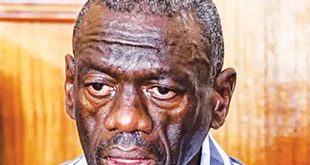
By Flavia Nassaka
Public health facilities are wretched and private care, insurance, are unaffordable
Edward Mubiru sits in the waiting area at International Hospital Kampala (IHK) located in Namuwongo, a suburb of Kampala. He continuously scrolls through his smart phone while his 50-year old mother is inside being reviewed by a doctor.
Nurses, doctors, and world-class consultants in their neatly starched green or blue uniforms or white lab coats hurry up and down the corridors within the cream-and-apple green painted walls and disinfected tiled floors. The waiting area has a comfy corporate-look with pine-wood and green metallic benches. Waiting patients can watch TV on over-hanging wall-mounted flat-screens.
The scene at IHK is similar to many private health facilities in Kampala. IHK is one of the most expensive private health facilities in Uganda and it is out of reach for most people. But Mubiru’s mother has been coming to IHK routinely since she was first diagnosed with a chronic heart disease in 2004.

Mubiru says he can afford it because his employer, MK Publishers Ltd, provides him with private medical insurance which also covers his family. He says before he was insured, his family went through tough times finding money to cater for his mother’s biweekly medical checkups. Many times they skipped doctor’s appointments because they did not have money.
Making sense of the cost of medical care in Uganda can sometimes prove confusing. Since IHK is billed as the top private hospital in Uganda, Mubiru expects its high rates.
Generally, they charge hefty consultation fees depending on the specialty of the medical personnel one wants to see. Tests and drugs prices vary with the disease, doses, and the drug manufacturing country. Most patients do not pay out of pocket. Many are insured, others run corporate accounts.
But even with the insurance cover, Mubiru sometimes has to pay for some services. This is because he does not have comprehensive insurance cover. Recently his wife was charged Shs 40,000 as consultation fees to see a gynecologist. There after she was billed Shs120, 000 for drugs for a bacterial infection. They could have gone to a middle-of-the way clinic, but it would not have made a difference really.
For example, about 300 meters from IHK is Mother Teresa Clinic and Laboratory. It is tiny, with bare equipment, and no reputation. Yet, for the same infection, it charges Shs 80,000 – just a fee 30% shy of the cost at the high end IHK. The question is why?
Paying for paper at Mulago
In search of answers, one must also visit the top public health facility in Uganda; the Mulago National Referral and Teaching Hospital also in Kampala but across town from IHK. The 53-year old facility is fully owned by the government and all its services are free – at least on paper. In reality, one has to pay for almost everything, including the paper on which the disease diagnosis and prescription is written.
The hospital handles about 6000 out-patients every day in addition to the 3000 in-patients. Ward 3B which houses the trauma unit epitomizes the challenges of coping with the large numbers. Everything seems desperate. Often, the beds run out and patients lie on the dirty-looking plain terrazzo floor.
Ismail Mbaziira was at Mulago. When I met him he was squatting besides a frail girl lying on a piece of cloth in the compound just in front of the pediatric ward. She is 3-years old and suffers from sickle-cell disease, a painful incurable hereditary condition. She had just suffered a severe episode but Mulago did not have medicine. Instead, her uncle had taken a prescription from the doctor and gone to a nearby pharmacy to buy the medicine.
Buying medicine outside the facility is not a surprise as Mbaziira says this happens all the time. He went through the same in 2011 when his brother was struck on the head by shrapnel from a landmine. He required a head operation and the neurosurgeon told them that they needed a specific drug that the hospital did not have at the time. It was an expensive drug. By the time the found the money to buy it, the patient had died.
The high cost of medical care; from the top private facilities to the low-class roadside clinics, and government-owned hospitals, has become a major concern.
Rich man’s healthcare
Uganda’s health system is structured in such a way that the rich go to exclusive private hospitals and clinics whereas the poor, who are the majority, have no choice but put up with the wretched government facilities.
According to Health Monitoring Unit (HMU) statistics, the Private sector delivers 50% of health care and medical products and also contributes 50% of health sector outputs. IHK alone handles between 300 and 500 outpatients per day whereas the In-patient beds are 100 yet the International Medical Group (IMG) to which IHK belongs has facilities across the country.
Grace Kiwanuka, the Executive Director of Uganda HealthCare Federation, an umbrella organization for private health facilities agrees that for the last five years, the cost of health care has been going up.
She says this is basically because private facilities do not receive any kind of support or funding from government. They have to depend on the market conditions to determine their charges.
“The cost of doing business has been going up. Until recently, banks have not been issuing loans to private hospitals to acquire equipment. We have to look for every single coin to ensure that workers are motivated and we have the right infrastructure,” she told The Independent. Then, she said, although imported medicinal drugs are not taxed, all equipment and drugs are priced in dollars, and so with the increase in the dollar, hospitals have to pass on these costs to patients.
Dr. Ian Clarke, who founded IHK and remains a director after selling majority shares to a Malaysian-based medical group, says top-class healthcare is costly because it relies on top specialists who are in short supply. He says doctors must charge a premium for their services. He says the government has failed to facilitate specialist doctors to remain in the country.
Dr. Abubakar Bugembe, an Ear, Nose and Throat (ENT) surgeon who runs a private clinic – Pan Health and also works at Mulago hospital says small private hospitals and clinics like his have come up to provide a choice to those people who cannot afford the expensive big private hospitals and yet cannot find treatment at the public hospitals.
At Bugembe’s clinic, consultation fees are Shs30, 000 – almost the same as IHK. But his clinic is at times crowded that people queue for the services. At facilities like these, the specialist professionals like Bugembe put a price on their skill. There is no government control on the cost.
So what happens to those who cannot afford high-end or low -end private healthcare, and yet fail to get free care from public facilities?
As it is now, apart from public facilities which offer free services, health expenditure mostly comes from out-of-pocket payments where the patient pays over the counter. This has pushed millions of people into a poverty trap especially when a sudden health crisis hits. Those who come out to offer cheaper services are at times quack medical personnel who end up feeding people on counterfeit medicines.
Cutting costs for the poor
Kiwanuka of the Uganda HealthCare Federation offers a practical solution to cutting costs. She says private health providers could unite and order drugs and equipment in bulk to keep the costs down other than each medical facility procuring the drugs on their own at a higher price.
From the government perspective, Dr. Asuman Lukwago, the Permanent Secretary in the Ministry of Health, says the government is now ready to give monetary support to some private facilities to enable them to subsidize their services. Apart from that, he says, there is nothing much the government can do since these facilities are set up by entrepreneurs to maximize profit.
Lukwago says the government is aware of the poor quality and access issues in public facilities, in addition to over worked medical personnel and his ministry is battling to ensure that the population gets decent medical services. Meanwhile, the public should bear with the government.
But Ian Clarke has what he calls `the only sensible way out’ – universal medical insurance.
“People budget for school fees on a regular basis, they should also budget for health expenses, rather than gambling that they will not get sick or have an accident,” he says, “they should take out health insurance.”
He says the beauty with insurance is that premiums have not risen in real terms for over a decade like they have in other countries in the region.
Clarke says, for the poor, if the Ministry of Health was organised there are schemes such as Voucher Schemes and Community Capitation Schemes which are very good value for money. He says a good example of such a scheme is at Kagando hospital where the community members pay a membership fee to the hospital and then get subsidized medical fees whenever they fall sick.
However, according to Lukwago, currently the government cannot afford an insurance system that covers everyone. He says, in fact, insurance is no bed of roses it is made out to be. He said there is need for the government to scrutinize the challenges associated with it before unleashing it on the general population.
Dr. Medard Bitekyerezo, a member of the Health Committee of parliament is more concerned with cost –even of insurance. He worries that it may be harder to see how people can pay for health insurance, especially since few Ugandans work in the formal sector where they might build up a fund.
For him, the solution lies in ensuring that private facilities do not take advantage of poor facilities in government hospitals to overcharge the patients.
“If public facilities are improved, the private charges will be made reasonable when the entrepreneurs do not find customers”.
 The Independent Uganda: You get the Truth we Pay the Price
The Independent Uganda: You get the Truth we Pay the Price


